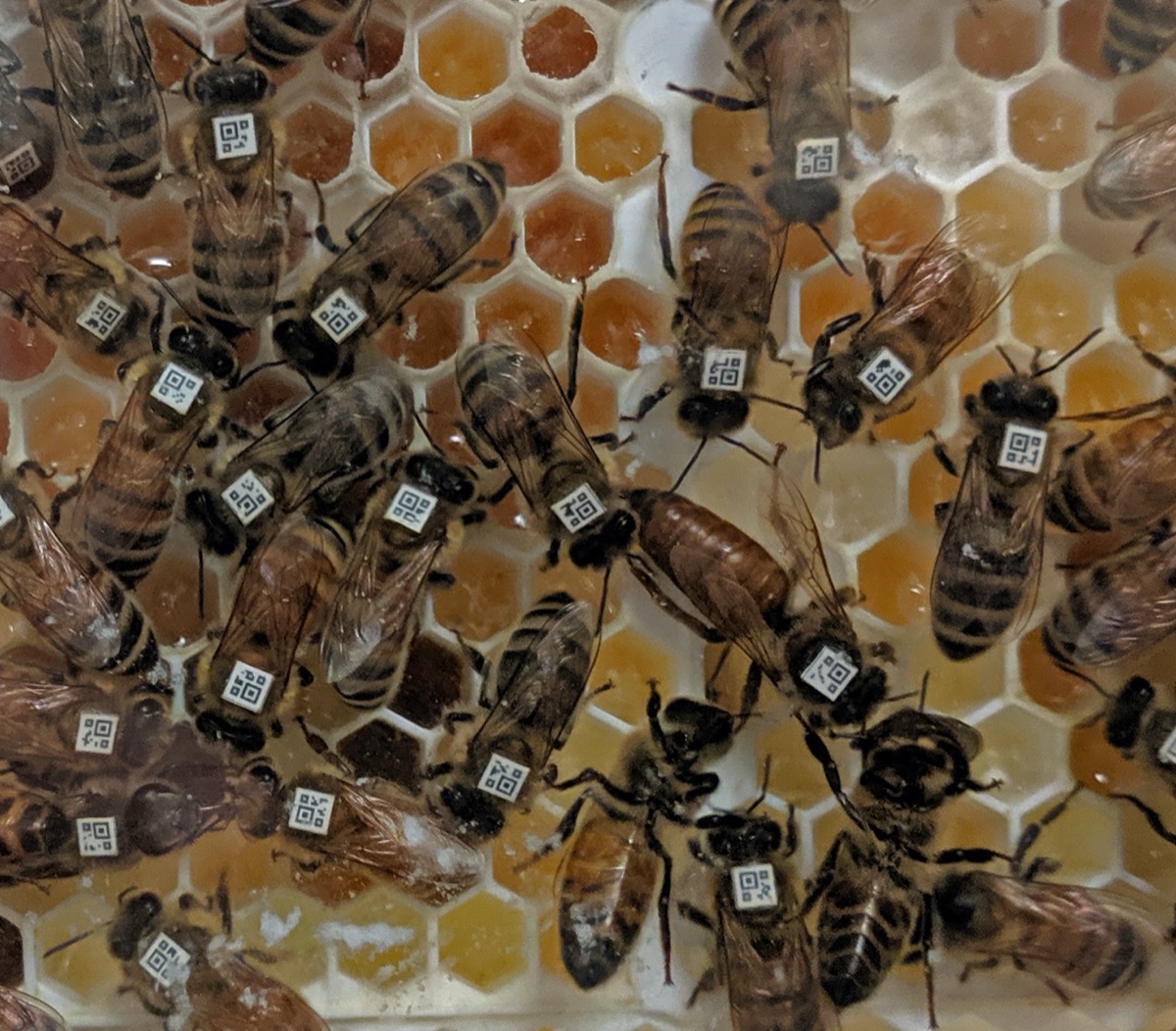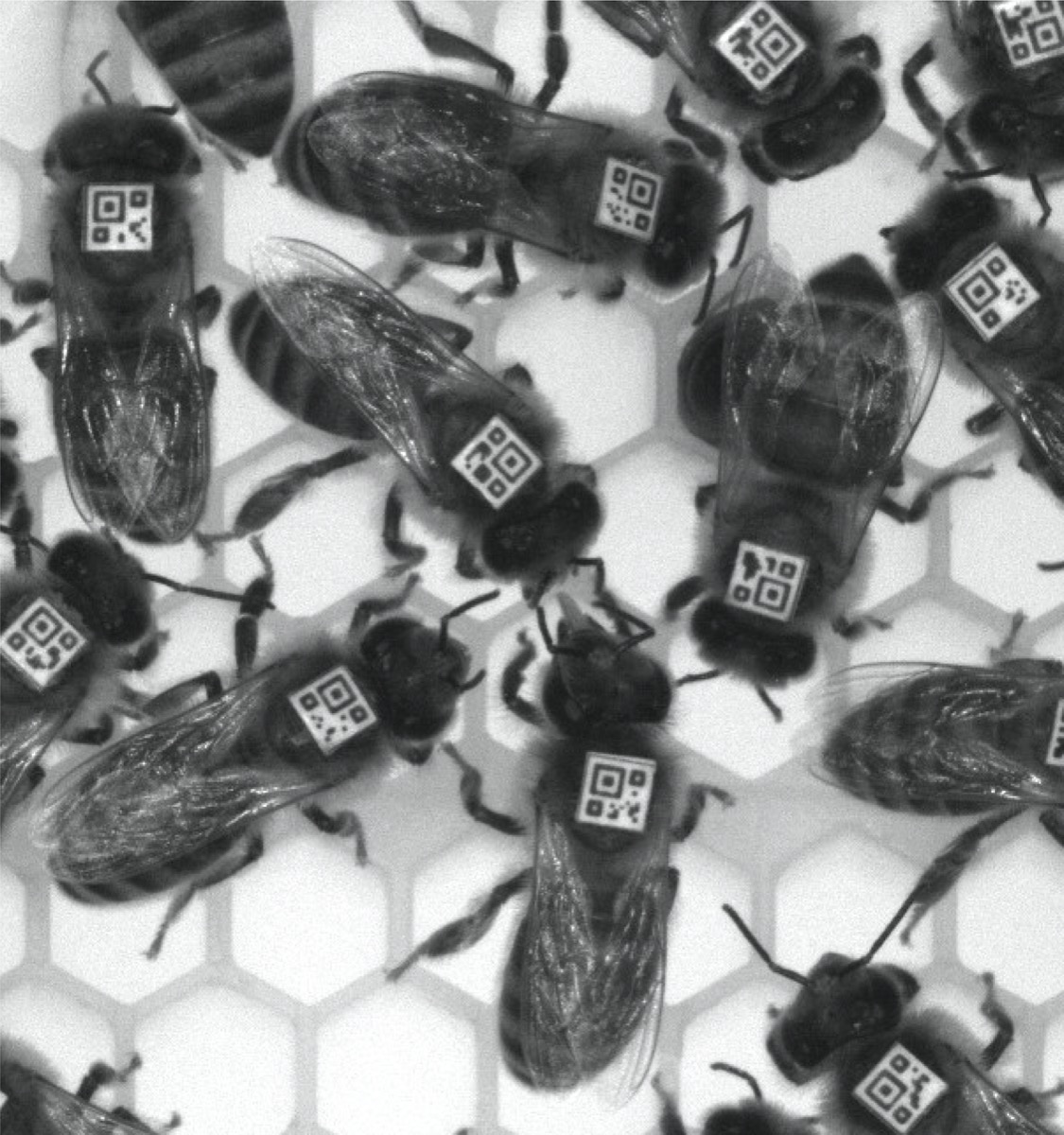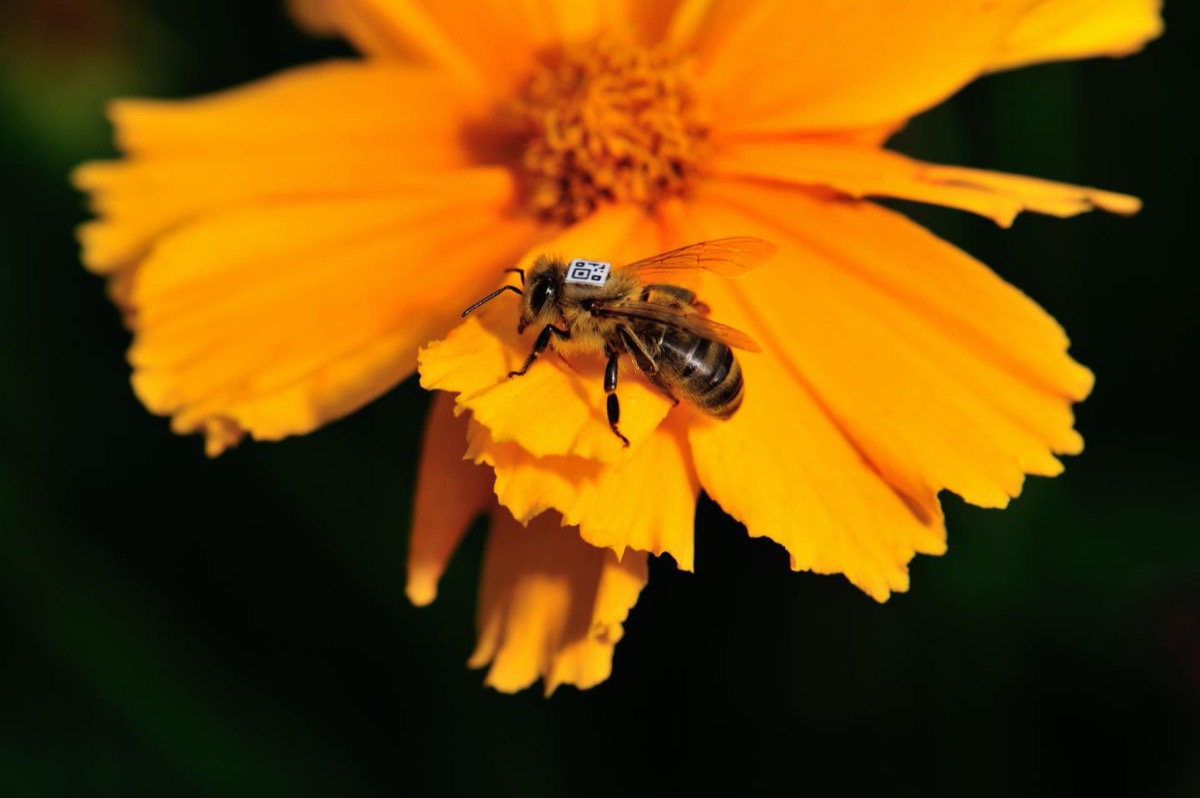A Viral Battle In The Honey Bee Hive
12:05 minutes

The coronavirus epidemic has certainly caused many humans to change behavior, like increasing handwashing and decreasing physical contact to slow the spread of the novel virus. That sort of defensive behavioral change isn’t unique to people, however.
New research published this week in the Proceedings of the National Academy of Sciences indicates that honey bees infected with a virus may alter their behavior in ways that slow the spread of the infection. At the same time, infection with the virus may help the bees sneak into neighboring hives, potentially spreading the virus to new hosts.
The researchers deliberately infected experimental hives with low levels of the Israeli Acute Paralysis Virus (IAPV). Each bee in the observation hive was tagged with a tiny bar code, allowing a computer algorithm to track the movement and behavior of individual bees within the hive. While infected bees seem just as active as healthy bees, they appear less likely to share food with other bees within the hive via a mouth-to-mouth sharing behavior called trophallaxis. That behavioral change could help slow the spread of infection within the hive.

When infected bees were placed at the entrance to neighboring hives, the guard bees there challenged the intruders as normal—but then allowed the infected bees access to the hive twice as often as uninfected foreign bees. The researchers believe that the infection changes the blend of chemicals on the surface of the bee to somehow make it smell more acceptable to the guards. Increased access to neighboring hives could allow infections to spread more easily from hive to hive.
Adam Dolezal, an assistant professor of entomology at the University of Illinois at Urbana-Champaign and one of the authors of the study, describes the research, and the evolutionary arms race that may be taking place between the bees and the virus.

Invest in quality science journalism by making a donation to Science Friday.
Adam Dolezal is an assistant professor in the Department of Entomology at the University of Illinois at Urbana-Champaign in Urbana, Illinois.
IRA FLATOW: This is Science Friday. I’m Ira Flatow. A bit later in the hour, a conversation with evolutionary biologist, Neil Shubin, about salamander tongues and fish swim bladders. Yeah– can tell us about the story of evolution and a hunt for long lost apples.
But first, the coronavirus has brought dramatic changes to our behavior, right? From wearing masks to handwashing to sheltering at home, all aimed at slowing the spread of disease. But a different virus may be causing some of our neighbors to be changing their behavior, too. I’m talking honey bees. Science Friday’s Charles Bergquist has more.
CHARLES BERGQUIST: Israeli acute paralysis virus is one of many diseases that can affect a honey bee hive. Over the course of a few days, infected bees first become paralyzed, then die. The virus is also linked to the spread of the varroa mite, a tiny parasite that attacks bees.
Writing this week in the Proceedings of the National Academy of Sciences, researchers say that they’ve found that Israeli acute paralysis virus, or IAPV, seems to be locked in an arms race with the bees with competing forces both pushing the spread of the virus and tamping it down. Joining me now to talk about what they found is one of the authors of that report, Adam Dolezal. He is an assistant professor in the Department of Entomology at the University of Illinois at Urbana-Champaign. Welcome to Science Friday.
ADAM DOLEZAL: Thanks for having me.
CHARLES BERGQUIST: First, what is Israeli acute paralysis virus?
ADAM DOLEZAL: IAPV is a RNA virus that is spread through a lot of different mechanisms by honey bees through their feeding of each other, but primarily, like you mentioned, through varroa mites. And it’s a virus that bees can carry around with very minimal symptoms a lot of the time.
But when it reaches high enough levels, causes these paralysis-like symptoms. And we know that this is a virus that is pretty common in honey bee hives, at least in the US and through much of the world. But it’s not quite ubiquitous like some other honey bee viruses are.
CHARLES BERGQUIST: And you deliberately infected some of your hives with the virus in order to observe its effects?
ADAM DOLEZAL: That’s correct. Yeah, so in this study, we used experimental infections where we just produce particles of this virus. We can actually just dissolve it in sugar solution and then feed it to bees for our experiments and infect them in a very controlled way.
CHARLES BERGQUIST: Once you do that, what happens to those bees? What do they start doing within the hive?
ADAM DOLEZAL: So in the study that we did here, we fed them a quantity of virus that doesn’t cause a lot of mortality. It infects the bees, but it doesn’t cause them to all become paralyzed and die. And what we found is that inside of a colony or in lab observations that mimic that, bees who are infected experience a lot less of this mouth-to-mouth food sharing behavior called trophallaxis. This is a behavior that bees do all the time in their colony.
They’re touching each other, grooming each other. They’re sharing food. And so this is a behavior that’s critical for colony success, but is also something that can transmit pathogens between individuals. And so we found that whether bees were infected with the virus or if their immune system was just turned up that they received less of these behaviors, they were less socially active in that way.
CHARLES BERGQUIST: So is it just that the bees are just holding up somewhere and saying, I don’t feel good, I’m going to go take a nap, so that they’re not interacting as much?
ADAM DOLEZAL: That’s a really good question. Because this virus does cause paralysis at high levels, you might expect bees to move less. But in fact, at the infection levels that we used, they appear to actually move more in some situations.
And at the very least, they move the same amount as a normal bee. So, no, they’re not holding up. They’re walking around the colony. They’re interacting with other bees. And they’re going in different places. But they are less likely to be part of that mouth-to-mouth food sharing behavior than control bees.
CHARLES BERGQUIST: Does that reduce the transmission of the virus within the hive itself?
ADAM DOLEZAL: We think it does. For this study, we were unable to actually track pathogen movement precisely. But we know from other studies that IAPV is transmitted orally, that it is transmitted through that mouth-to-mouth food chain behavior, both between workers and also between the workers and the queen. And so by reducing this, we think that this reduces the overall probability of the disease being transmitted through the colony.
CHARLES BERGQUIST: Do you know who’s initiating that restraint? Is it the bee saying, I don’t feel good, I’m not going to interact with you? Or is it somehow the healthy bees recognizing, hey, that bee is not right? I’m not going to– I’m going to stay away from them?
ADAM DOLEZAL: At this point, we’re not 100% sure. Either one would be a viable mechanism to reduce that behavior. However, one of the other things that we did in this study was measure the particular hydrocarbons, the chemicals on the outside of a bee’s body that communicate information to other bees.
And we found that when bees are infected or their immune system is turned on, their hydrocarbon profile changes. So they appear to smell different. And so there is a signal change there that could be picked up by the healthy bees and cause them to change their behavior in response to the sick bee.
CHARLES BERGQUIST: But you found that there was something else going on when those infected bees left the hive and encountered a neighboring hive.
ADAM DOLEZAL: Right. So we did a series of experiments where we took infected bees or immune stimulated bees and we presented them to the guard bees of another colony. The guard bees of colonies are their line of defense against intrusion from predators, but also from other bees from other colonies who might come in and try to steal honey or spread pathogens.
And we found that bees who were infected with IAPV received a lot less of the guard aggression that we normally see. And we saw this both in lab assays, where we can record their behaviors carefully. We also saw it in real field colonies that we set up. And then we introduced to their entrances– infected or uninfected bees.
And we found that those who were infected were accepted into this foreign colony about twice as often as controls. And so it appears that IAPV is giving the bees who are infected some ability to circumvent other colonies’ defenses to somehow get through that line of guards and enter into the colony itself.
CHARLES BERGQUIST: Is that smell cue like a identification system, like a passport? Or is it some sort of calming– these aren’t the droids you’re looking for, confusion thing?
ADAM DOLEZAL: Honey bees use these hydrocarbons, these chemicals on the outside of their body as a marker of what colony they belong to. When honey bees return to their colony, the guard bees normally stop them and smell them with their antennae and see. Do you smell like someone who lives in this colony?
And if they do, they’re allowed entrance. And if they don’t, then they are often attacked or rejected, prevented from entering. And so we see a number of different compounds changing with infection, but we don’t know exactly what any specific one might be doing.
Whatever’s happening, it’s allowing bees to gain entrance into– really appears any foreign colony. So they’re not mimicking the smell of colony B over there because they don’t know it. But something about their profile is making them more acceptable to those guard bees. And it’s not just that the guard bees are ignoring them.
The guard bees do stop and antennate them and even do that mouth-to-mouth food sharing behavior with them. So it’s not as if they’re invisible. It’s something else going on. They’re there. The guard bees interact with them. But then they ultimately make the decision to allow a lot more of them into the colony than they normally would.
CHARLES BERGQUIST: So if this is a evolutionary arms race going on here between the bees damping down the spreading behavior within their own hives and the virus somehow encouraging spreading outside, who’s winning the race?
ADAM DOLEZAL: That’s a really good question. One challenge I’ll note is that we really don’t know how effective that tamping down effect is. The evidence we have suggests that this is a pretty general response. And people have seen similar responses with other types of stresses to bees. It may be that this is just a general response that happens when bees are infected with lots of different pathogens.
And we actually don’t know how successful it is at preventing transmission of IAPV. Similarly, we don’t really know how successful of a strategy it is to get diseased individuals from colony A to colony B. But it seems that on a whole, the ability to move from an infected or infested colony to susceptible ones in your apiary very quickly would be more successful.
CHARLES BERGQUIST: How do you even go about observing and tracking the behavior of a whole hive full of bees and monitoring this one infected bee is doing a certain behavior?
ADAM DOLEZAL: People have been using what are called observation hives to study bees for a long time. These are special colonies with glass walls. And they’re usually kept inside of a building, so a human can observe them and write down what number marked bees are doing.
But at any given moment, you can only observe so many bees. Even with a video camera, it becomes very challenging to figure out what’s going on. And so one of the exciting things about this study is that I was able to work with Tim Gernat and Gene Robinson who had developed recently a automated behavioral monitoring system.
In this system, it uses an observation hive, just like bee biologists have used for a long time. But instead of a human observer, each bee has an individualized little tag on its back that looks like a QR code. And a camera takes a picture of that colony every second of the entire experiment. And then a computer is able to figure out where every bee is, its orientation.
And then it’s also even able to look at how their heads are oriented and how their tongues are to identify this food sharing behavior. And so it’s able to identify orders of magnitude, more of these behaviors than a human observer ever could. And so it’s giving us an opportunity to see bee behavior at a resolution that really has never been before possible.
CHARLES BERGQUIST: Does this study have any parallels to how humans are living today?
ADAM DOLEZAL: I think that it’s hard not to draw some parallels here. Honey bees, like humans, are really social animals. They live in these large groups. They interact with each other constantly. They need to interact with each other constantly. They become very stressed if they don’t.
But they also have the ability to sense that a pathogen is making them sick or making one of their group members sick and do behaviors to reduce the spread of that pathogen. And this is something I think that we could view very similarly to our own public health efforts to reduce social contacts among humans in the face of a pandemic, that we can change our behaviors to change the virus’s transmission.
CHARLES BERGQUIST: Adam Dolezal is an assistant professor in the Department of Entomology at the University of Illinois at Urbana-Champaign. Thanks for joining me today.
ADAM DOLEZAL: Thank you.
CHARLES BERGQUIST: And if you’d like to see some images of barcoded bees, visit our website at sciencefriday.com. I’m Charles Bergquist for Science Friday.
Copyright © 2020 Science Friday Initiative. All rights reserved. Science Friday transcripts are produced on a tight deadline by 3Play Media. Fidelity to the original aired/published audio or video file might vary, and text might be updated or amended in the future. For the authoritative record of Science Friday’s programming, please visit the original aired/published recording. For terms of use and more information, visit our policies pages at http://www.sciencefriday.com/about/policies/
As Science Friday’s director and senior producer, Charles Bergquist channels the chaos of a live production studio into something sounding like a radio program. Favorite topics include planetary sciences, chemistry, materials, and shiny things with blinking lights.